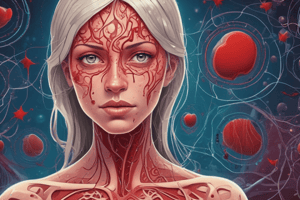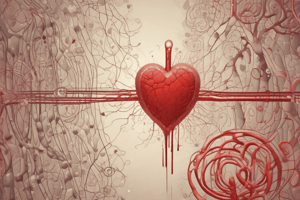Podcast
Questions and Answers
What is the result of a mutation leading to hemophilia?
What is the result of a mutation leading to hemophilia?
- Insufficient clotting factors (correct)
- Normal clotting factors
- Increased platelet production
- Excessive clotting factors
Sickle cell disease alleles provide no protection against malaria.
Sickle cell disease alleles provide no protection against malaria.
False (B)
What is a major consequence of polycythemia?
What is a major consequence of polycythemia?
Thickened blood
Hemophilia is more common in __________ because they have only one X chromosome.
Hemophilia is more common in __________ because they have only one X chromosome.
Match the following blood-related terms with their descriptions:
Match the following blood-related terms with their descriptions:
What is the effect of factor XIII(13) in blood clotting?
What is the effect of factor XIII(13) in blood clotting?
If clots form too easily, it may result in hemorrhage.
If clots form too easily, it may result in hemorrhage.
What are the antibodies that bind to A and B antigens called?
What are the antibodies that bind to A and B antigens called?
Excessive blood loss from a failure to form clots may result in ______________.
Excessive blood loss from a failure to form clots may result in ______________.
Match the conditions to their definitions:
Match the conditions to their definitions:
What blood types can an individual with blood type O safely receive?
What blood types can an individual with blood type O safely receive?
Julia is blood type O and makes antibodies against ______________ antigens.
Julia is blood type O and makes antibodies against ______________ antigens.
Which of the following components of blood is primarily responsible for hemostasis?
Which of the following components of blood is primarily responsible for hemostasis?
The extrinsic clotting pathway is primarily activated by internal factors of the bloodstream.
The extrinsic clotting pathway is primarily activated by internal factors of the bloodstream.
What is the scientific study of blood and blood-forming tissues called?
What is the scientific study of blood and blood-forming tissues called?
Blood accounts for approximately ___% of total body mass.
Blood accounts for approximately ___% of total body mass.
Match the blood group with its characteristics:
Match the blood group with its characteristics:
Which coagulation factor is involved in the common pathway of blood coagulation?
Which coagulation factor is involved in the common pathway of blood coagulation?
Hemolytic disease of the newborn (HDN) can occur when the mother is Rh-negative and the baby is Rh-positive.
Hemolytic disease of the newborn (HDN) can occur when the mother is Rh-negative and the baby is Rh-positive.
What is thrombosis?
What is thrombosis?
The primary function of blood involves the transportation of ___, nutrients, hormones, and waste products.
The primary function of blood involves the transportation of ___, nutrients, hormones, and waste products.
What is the correct order of steps in the intrinsic clotting pathway?
What is the correct order of steps in the intrinsic clotting pathway?
Flashcards
Blood Clotting Regulation
Blood Clotting Regulation
Blood clotting is tightly controlled to prevent damage to blood vessels. Formation of clots must be precisely balanced to avoid thrombosis and hemorrhage.
Thrombosis
Thrombosis
A condition characterized by the formation of unnecessary blood clots within blood vessels.
Embolism
Embolism
The blockage of a blood vessel by an embolus (a blood clot, air bubble, or foreign substance).
ABO Blood Groups
ABO Blood Groups
Signup and view all the flashcards
Agglutination
Agglutination
Signup and view all the flashcards
Rh factor
Rh factor
Signup and view all the flashcards
Hemolytic Disease of the Newborn (HDN)
Hemolytic Disease of the Newborn (HDN)
Signup and view all the flashcards
Blood composition
Blood composition
Signup and view all the flashcards
Blood functions
Blood functions
Signup and view all the flashcards
Erythropoiesis
Erythropoiesis
Signup and view all the flashcards
White blood cells
White blood cells
Signup and view all the flashcards
Inflammation
Inflammation
Signup and view all the flashcards
Platelets
Platelets
Signup and view all the flashcards
Hemostasis
Hemostasis
Signup and view all the flashcards
Blood clotting pathways
Blood clotting pathways
Signup and view all the flashcards
Blood groups (ABO, Rh)
Blood groups (ABO, Rh)
Signup and view all the flashcards
Sickle Cell Anemia
Sickle Cell Anemia
Signup and view all the flashcards
Alleles
Alleles
Signup and view all the flashcards
Malaria Resistance
Malaria Resistance
Signup and view all the flashcards
Hemophilia
Hemophilia
Signup and view all the flashcards
Polycythemia
Polycythemia
Signup and view all the flashcards
Study Notes
Blood Overview
- Blood is a liquid extracellular matrix with cellular components
- Blood makes up about 8% of total body mass (5-6 L in males, 4-5 L in females)
- Blood temperature is kept around 38°C and pH is 7.35-7.45
- Blood has three main functions: transportation, regulation, and protection
Blood Composition
- Blood plasma (55%): pale yellow liquid, 91.5% water and 8.5% solutes
- Mostly proteins (albumin, globulins, fibrinogen)
- Other solutes (1.5%): electrolytes, nutrients, gases, hormones, wastes
- Formed elements (45%): erythrocytes, leukocytes, platelets
- Erythrocytes (red blood cells): most abundant, transport O₂ and CO₂
- Biconcave discs, lack organelles (mitochondria)
- Contain hemoglobin (Hb) for oxygen binding
- ~ 120-day lifespan; destroyed by macrophages, iron recycled
- Leukocytes (white blood cells): various types, defend against infection
- Granular: neutrophils, eosinophils, basophils (phagocytic, release chemicals)
- Agranular: lymphocytes, monocytes (phagocytic)
- Platelets (thrombocytes): fragments of megakaryocytes, crucial for clotting
- Erythrocytes (red blood cells): most abundant, transport O₂ and CO₂
Blood Cell Formation (Hematopoiesis)
- Occurs in red bone marrow (axial skeleton and epiphyses of long bones)
- Begins with pluripotent stem cells
- Differentiates into myeloid and lymphoid stem cell lines
- Myeloid: erythrocytes, leukocytes (neutrophils, eosinophils, basophils, monocytes) platelets
- Lymphoid: lymphocytes
Hematopoeitic Growth Factors
- Erythropoietin (EPO): from kidneys, stimulates erythrocyte production
- Thrombopoietin (TPO): from the liver, stimulates platelet formation
- Cytokines: stimulate leukocyte production
Blood Cell Life Cycle
- Erythrocytes (RBCs): ~120 day lifespan; broken down continuously
- Worn-out/damaged RBCs are removed by macrophages in spleen and liver
- Iron, globin, and heme components are recycled
Blood Clotting (Hemostasis)
- Prevents hemorrhage
- Three main steps:
- Vascular spasm: constriction of blood vessels
- Platelet plug formation: platelets adhere to damaged endothelium
- Blood clot formation: insoluble fibrin reinforces platelet plug
Regulation
- Hypoxia (low oxygen): kidneys release erythropoietin
- Stimulus: decrease in oxygen delivery to tissues
Blood Types
- ABO and Rh classifications
- Based on presence or absence of antigens on erythrocyte membranes
- Agglutination occurs when antibodies bind to antigens
- Transfusions require matching blood types (avoiding agglutination reactions).
Blood Diseases
- Anemia: low erythrocyte count or deficient hemoglobin; can be caused by iron deficiency, vitamin B12 deficiency, etc.
- Sickle cell disease: genetic mutation in hemoglobin; results in abnormal RBC shape potentially causing clotting.
- Hemophilia: inherited bleeding disorder where clotting factors are missing or deficient.
- Polycthimea: too frequently production of RBCs.
- Hemolytic Disease of the Newborn (HDN): incompatibility of maternal and fetal blood types resulting to erythrocyte destruction; this usually happens during a second pregnancy.
Additional key terms
- Antibodies: proteins in blood that bind to foreign antigens
- Antigens: molecules on the surface of cells that trigger immune responses
- Plasma: liquid component of blood
- Clotting factors: proteins necessary for blood clot formation.
- Hemoglobin: protein containing iron, that carries oxygen.
- Histamine: chemical that induces inflammatory responses.
Studying That Suits You
Use AI to generate personalized quizzes and flashcards to suit your learning preferences.




